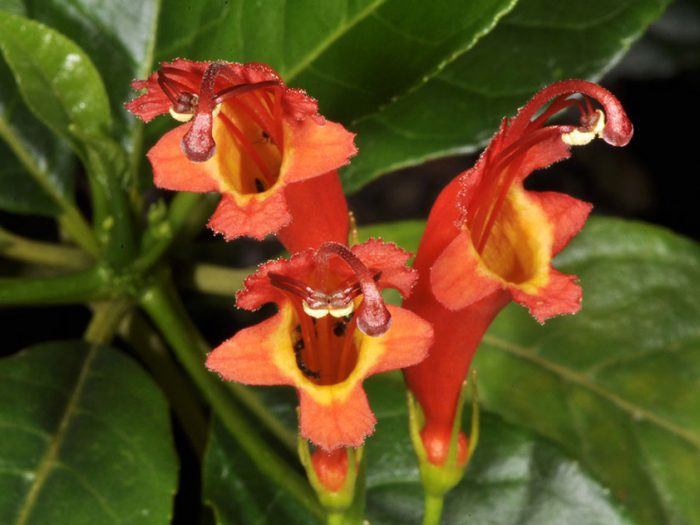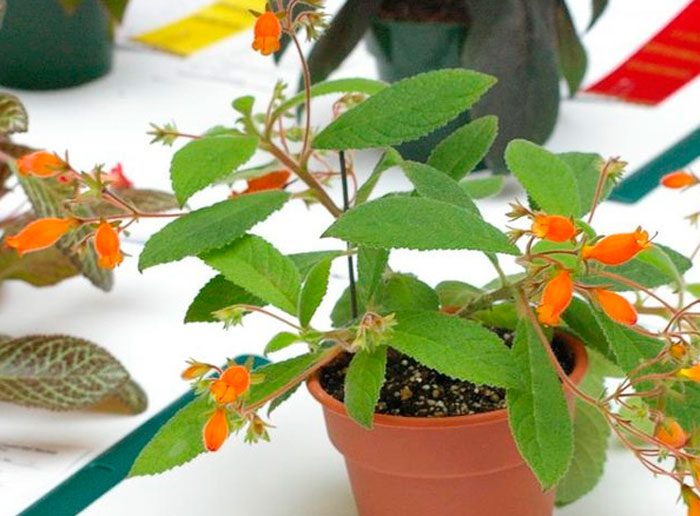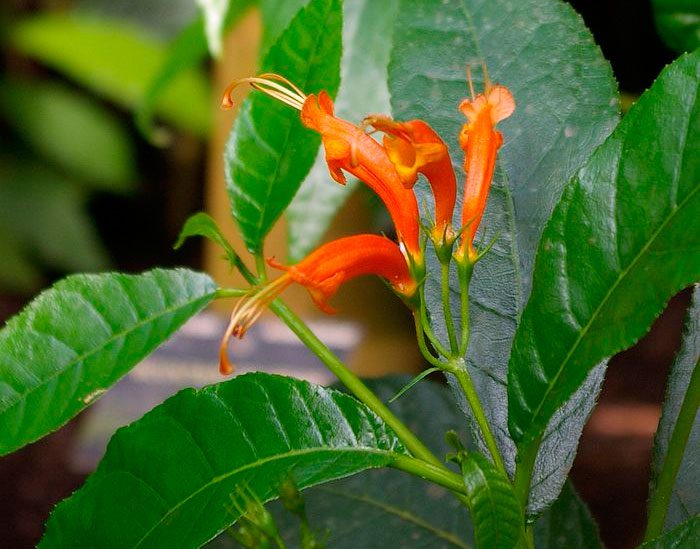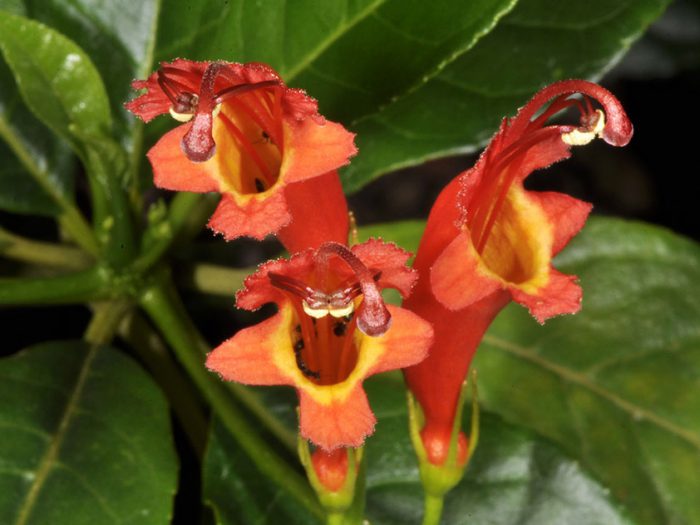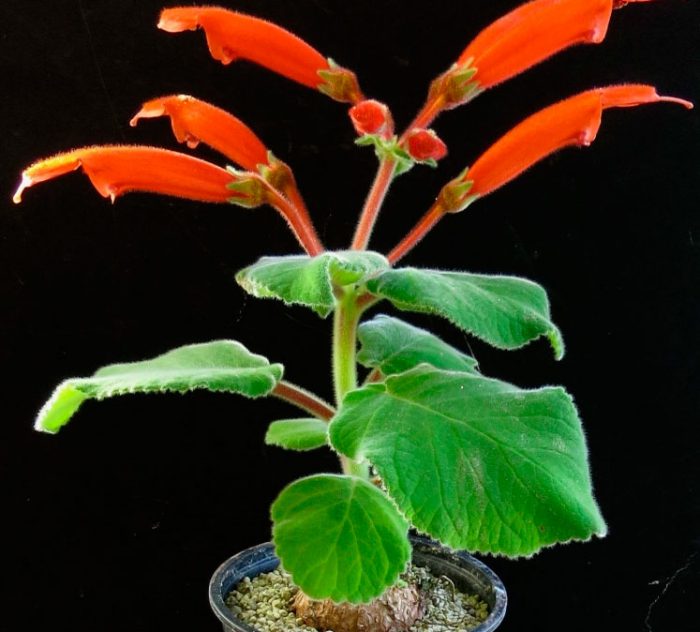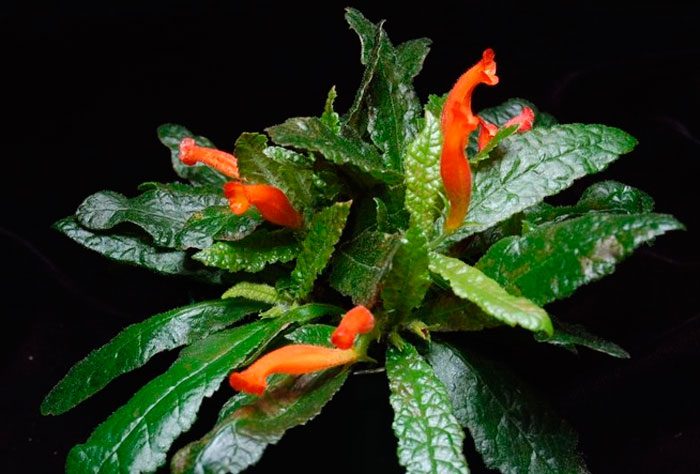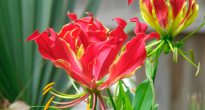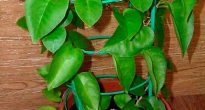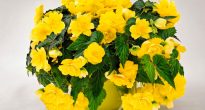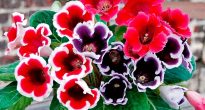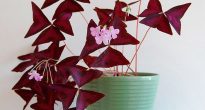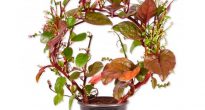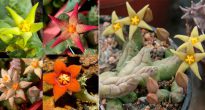Evergreen gesneria (Gesneria) is a perennial and is directly related to the Gisneriaceae family. This plant comes from the tropical regions of America, as well as from the Antilles.
This genus was named after the Swiss scientist Konrad Gesner (1516-1565), who was a natural scientist.
Gesneria is represented by shrubs or herbaceous plants, which can reach a height of 60 centimeters. On the surface of erect shoots, there is pubescence, and tuberous rhizomes are velvety. The juicy leaves are oval in shape. Tubular flowers can be single axillary or they are part of the apical few-flowered inflorescences that have the shape of an umbrella. Yellow or red petals have a bend.
Gesneria care at home
Illumination
You need bright, but at the same time, diffused lighting. It is necessary to shade from direct sunlight. Recommended to be placed on windows with western or eastern orientation. The south window will require shading from direct sunlight. They can grow normally even in full artificial light.
Temperature regime
In spring and summer, gesneria needs a temperature of 20 to 25 degrees. At the same time, in winter, she needs a temperature above 18 degrees, but only if she is not sent to rest.
Humidity
It grows and develops normally only at high air humidity. However, it should be noted that it is impossible to moisten the plant from the spray bottle. In order to increase the humidity, experienced flower growers advise, take a relatively wide pallet and put sphagnum in it, or add expanded clay and pour in a small amount of water. Care must be taken that the bottom of the container does not come into contact with the liquid.
How to water
During intensive growth, abundant watering is required. It is produced after the top layer of the substrate has dried. For a plant, both overdrying of an earthen coma and overmoistening (capable of provoking the formation of rot) are equally harmful. Watered with exceptionally soft lukewarm water. After the plant has faded, watering must be reduced. It is recommended to water through a drip tray to avoid getting liquid onto the foliage surface.
Top dressing
Top dressing is carried out in spring and summer 1 time in 2 weeks.For this, a complex liquid fertilizer for flowering plants is used.
Dormant period
Has a distinct period of rest, lasting 8-10 weeks (usually from the end of October to January). When the plant fades, watering must be reduced, and after the foliage is completely dry, the tubers must be removed from the soil and placed in the sand for storage. Keep the tubers in a cool dry place (12 to 14 degrees).
Transplant features
The tubers should be removed from the sand in January – early February. They are placed for a third of an hour in a weak solution of potassium manganese or fungicide. Then the tubers are planted in a fresh soil mixture, for the preparation of which it is necessary to combine peat, leaf and humus soil, as well as sand, taken in equal proportions. Do not forget to make a good drainage layer at the bottom of the container.
You need to plant tubers in such a way that their buds are on the surface. In this case, the stems appear faster.
Reproduction methods
You can propagate by cuttings or seeds.
Sowing seeds produced in spring or autumn, while they do not need to be buried in the soil. It is recommended to keep the temperature within 22 degrees. Seedlings should be dived into small containers at a distance of 2x2 centimeters. After the plants grow up, they are dived again, while the distance between them should be 4x4 centimeters. Do not let the temperature drop below 20 degrees and shade from direct sunlight. We need systematic watering.
The grown seedlings are planted in separate pots (diameter 6–7 centimeters). After the root system ceases to fit in the container, young Gesnerias should be transferred into a container with a diameter of 9 to 11 centimeters. The first flowering is observed after 2-3 years.
Cuttings recommended in May – August. The leaves or parts of them act as cuttings (the leaf plate must be cut across into 2 or 3 pieces). They are planted in the sand, and you need to bury the base or the lower part of the leaf fragment. You need a temperature of at least 25 degrees. Tiny tubers are formed after 40–45 days. Plants need to be regularly watered and protected from direct sunlight. In the last days of September, watering should be reduced and the air temperature should be lowered to 20 degrees. Dig up young tubers in October and store them in a cool, dry (12 to 14 degrees) place until spring. Such gesnerias will bloom in the 2nd year of life.
Pests and diseases
Most often, the plant suffers from violations of the rules of care, for example: improper watering regime, excessively low air humidity, poor lighting in winter.
It is also not uncommon for sunburns to appear on the surface of foliage. And yellowish spots can appear from cold water used for irrigation, or due to the ingress of liquid on the surface of the leaf plate.
The plant can settle aphids, spider mites, thrips, whitefly or scabbards.
Main types
Gesneria swollen (Gesneria ventricosa)
This weakly branching shrub is a perennial. The petiole leaves are oblong, wedge-shaped at the base, and pointed at the tips. The fleshy, leathery, bare leaf plates have a jagged edge, ranging in length from 10 to 15 centimeters, and their width from 3 to 5 centimeters. The apical inflorescence bears 4 or 5 flowers and is located on a long peduncle. The calyx has narrow long teeth in the amount of 5 pieces. The corolla has a funnel-shaped tubular shape and reaches 3 centimeters in length. It has a reddish-orange color, while the inner surface of the corolla, the pharynx and swelling at the base of the tube are colored yellow.
Gesneria hybrid (Gesneria hybrida)
This perennial is a tuberous herb. Its velvety green leaf plates are large.Slightly swollen, red tubular flowers reach a length of 5-7 centimeters.
Gesneria cardinal, or scarlet (Gesneria cardinalis)
Such a herbaceous plant is a perennial. The height of its erect shoots can reach 30 centimeters. Fleshy green obtuse-toothed leaf plates at the edges have a wide-oval shape, and on their surface there is a dense pubescence. They can be up to 10 centimeters long. Flowers are either single or collected in axillary or apical few-flowered inflorescences. Such tubular flowers are two-lipped, while the part located below is slightly smaller than the upper one. In length, they can reach from 5 to 7 centimeters. Basically, the flowers are painted in a deep red color, and there are dark dots in the pharynx (there are other colors).
Gesneria cuneiform (Gesneria cuneifolia)
This compact shrub is a perennial. It reaches a height of 30 centimeters, and its shortened shoots are semi-lignified. Almost sessile or short-petiolate leaflets have an inversely lanceolate-wedge shape, while their base is rounded wedge-shaped. In length, they can reach 10 to 12 centimeters and are approximately 3 centimeters wide. The front surface of the foliage is colored green, and the back is pale green, and there are small whitish hairs on it. Saturated red flowers on the underside have an orange tint. The peduncle is long and thin.
Gesneria Lebanese (Gesneria libanensis)
This compact evergreen shrub is weakly branched and is a perennial. At the tops of the stems there are lanceolate leaves, which are collected in rosettes, and at the edges they are serrate. They have pubescence on the front surface, while on the seamy surface, pubescence is present only along the veins. Their length is 8-10 centimeters. The length of deep red flowers is from 3 to 5 centimeters.

